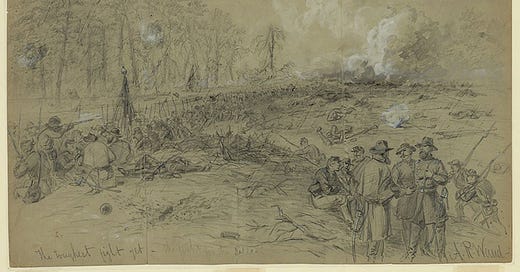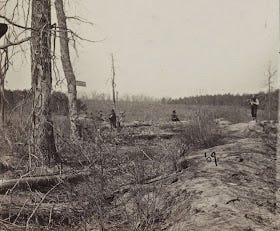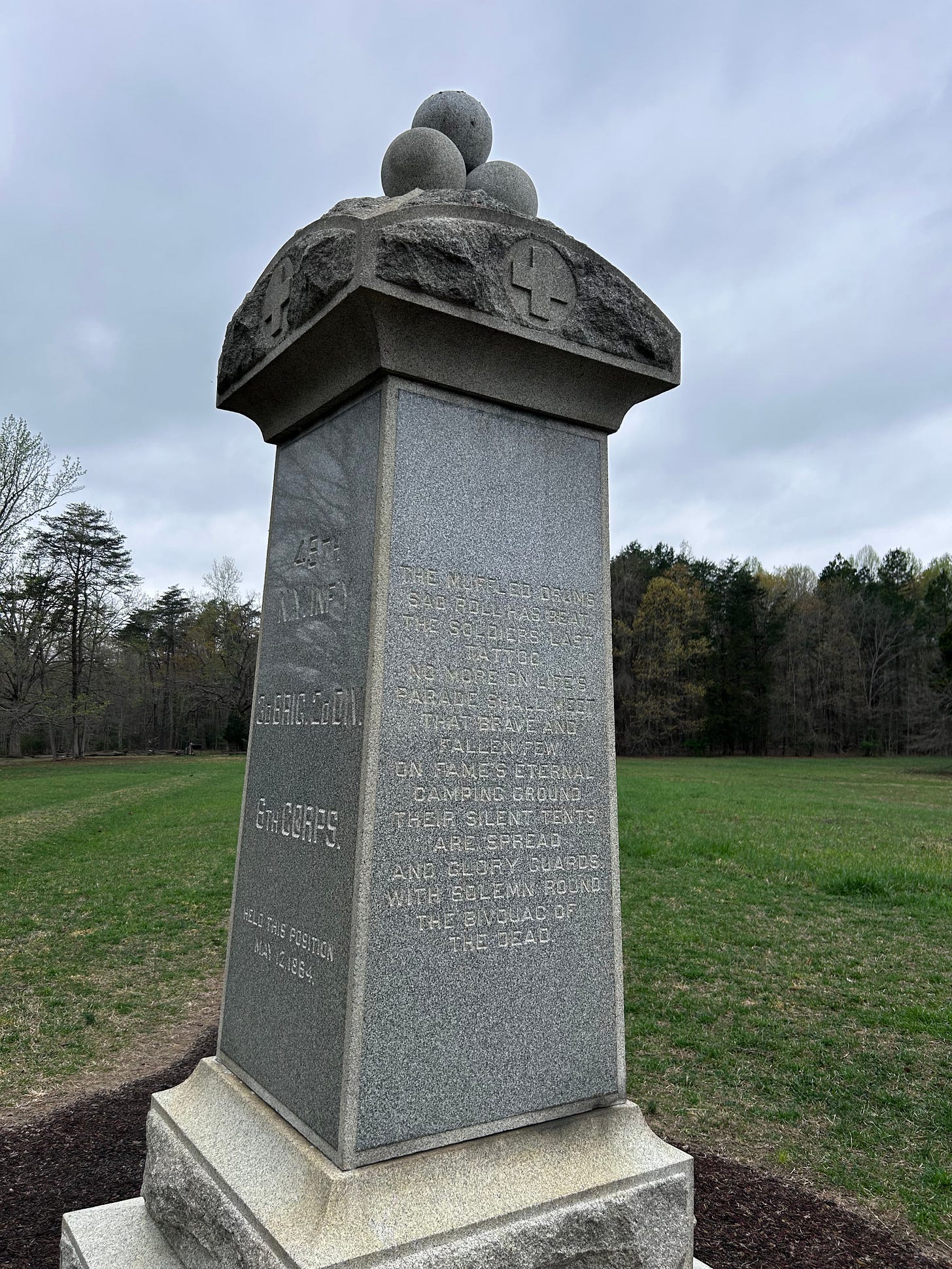William Waud’s drawing of the battle for the Bloody Angle
I returned from Gettysburg today, making a brief stop at the Spotsylvania Courthouse National Battlefield. I could only spend about an hour there because I had to get home, so I made the most of my time by walking the ground around the Muleshoe Salient, in particular the tiny section of the battlefield called “The Bloody Angle”. I will have to make another trip over a weekend to spend more time there and at the Fredericksburg, Chancellorsville and Wilderness battlefields which are in the area. The Angle is a particularly hallowed bit of ground, and I will come back to that. When I visit a place like it I am reminded of Walt Whitman’s words.
“Ashes of soldiers South or North,
As I muse retrospective murmuring a chant in thought,
The war resumes, again to my sense your shapes,
And again the advance of the armies.
Noiseless as mists and vapors,
From their graves in the trenches ascending,
From cemeteries all through Virginia and Tennessee,
From every point of the compass out of the countless graves,
In wafted clouds, in myriads large, or squads of twos or threes or
single ones they come,
And silently gather round me…”
Spotsylvania is a good sized battlefield. The fight between 100,000 Union soldiers and 52,000 Confederates during the Overland Campaign of LTG Ulysses S. Grant and Army of the Potomac Commander MG George Gordon Meade against Robert E. Lee’s Army of Northern Virginia lasted from May 8th to 23rd 1864. It was a continuation of the fight that started in the Battle of the Wilderness which took place from 5-7 May, after which Lee withdrew and dug field fortifications in the densely wooded area. That battle was fought very near the Chancellorsville battlefield, where Lee had won a Pyrrhic victory against the Army of the Potomac just a year before.
Grant’s plan was to destroy Lee’s Army regardless of the cost, and not repeat the errors of past Union commanders who after taken heavy casualties would withdraw and give Lee the chance to recover and rebuild his Army. This campaign would be different. Grant was not going to let Lee get away or give the Army of Northern Virginia any respite, and Grant’s forces were much better able to deal with the vast numbers of casualties than Lee.
Grant was going to do his part to end the war and he had unleashed William Tecumseh Sherman and his armies against the heart of the south, Georgia. Their campaigns would transform the war into the first modern war. Lee, the consummate disciple of Napoleon Bonaparte did not expect the change.
Giving Lee’s army no respite, Grant continued the battle on 8 May. I will not deal with the first days of the battle now, though they are worth writing about later. Tonight’s focus is on the fight for The Angle.
After the initial parts of the battle, Lee tried to keep his lines connected withdrew into a salient nicknamed The Muleshoe. Salients are often exposed and difficult to defend. This would be no different from others. Grant’s forces launched a surprise predawn attack on it the morning of 12 May with superior numbers catching Lee unprepared, in face one of his commanders withdrew his artillery from it, returning the artillery in time only to be overrun and captured by the advancing soldiers of MG Winfield Scot Hancock’s II Corps who also captured 4000 soldiers of Confederate Major General Allegheny Johnson’s division, including Johnson and the brigade commander.
The initial breakthrough was stopped by Lee who rushed as many troops as he could to the threatened position, after which the fighting became a struggle for a tiny parcel of land barely a half mile square. The Confederates were in well prepared trenches which were reinforced with wooden logs with earth from the trenches in front. A gap was placed between the logs for the Confederate troops to fire from without exposing themselves to the rifle fire of Union troops. Union forces were yards away, the assaulting infantry in a ravine in front of the Confederates, with supporting troops and artillery a short distance behind.
Federal forces continued their attacks. Grant was fighting to win the war, and Lee to save his army from annihilation. Over the next 20 hours the Army of the Potomac continued its attacks against the Confederates, and their dead and wounded lay in front of the Confederate positions, five to six deep. Grant’s aide Horace Porter wrote:
“The appalling sight presented was harrowing in the extreme. Our own killed were scattered over a large space near the "angle," while in front of the captured breastworks the enemy's dead, vastly more numerous than our own, were piled upon each other in some places four layers deep, exhibiting every ghastly phase of mutilation. Below the mass of fast-decaying corpses, the convulsive twitching of limbs and the writhing of bodies showed that there were wounded men still alive and struggling to extricate themselves from the horrid entombment. Every relief possible was afforded, but in too many cases it came too late. The place was well named the "Bloody Angle”.
In the 22 hours that transpired between the beginning of the Federal attack and Lee’s withdrawal from the Muleshoe, casualties in the Angle came to almost 18,000 Union and Confederate killed, wounded, captured or missing.
Today, the remains of the Confederate earthworks are still visible and visitors can walk through the area. Unlike Gettysburg which is often overwhelmed with visitors, Spotsylvania is rather isolated and the battlefield is almost unearthly quiet, except for the chirping of birds and the rustling of the trees in the breeze. The quiet allows a person who knows something of the battle to contemplate what happened on 12-13 May 1864, especially men or women how have served in war on battlefields far away from home who might not ever have the chance to return to those places. I think that is why Whitman’s poem comes to mind.
Likewise, having been to war I often contemplate the words of Joshua Chamberlain, the hero of Little Round Top who was grievously wounded at Petersburg and survived to help receive the surrender of Lee’s Army of Northern Virginia at Appomattox on 9 April 1865, just under 11 months following the battle for the Angle. He wrote:
Chamberlain, who was a professor or revealed religion and rhetoric at Bowdoin College, who also served in the Wilderness and Spotsylvania asked the most difficult questions when viewing the devastation around Petersburg in the final days of the war:
“…men made in the image of God, marred by the hand of man, and must we say in the name of God? And where is the reckoning for such things? And who is answerable? One might almost shrink from the sound of his own voice, which had launched into the palpitating air words of order–do we call it?–fraught with such ruin. Was it God’s command that we heard, or His forgiveness that we must forever implore?
I think that is still an important question regarding war, regardless how righteous or unrighteous it might be. Even if our cause right, our involvement legal under international law and is waged in as ethical manner as humanly possible. The question must still be asked.
On another note, I was unable to attend any of the “Hand’s Off” protests but I am pleased. The resistance is gaining ground and spreading. This is something that did not happen in Nazi Germany until it was far too late. Thus I believe that the American people are beginning to away from their stupor following Trump’s election victory and the Blitzkrieg of unconstitutional “Executive Orders” and the action of Elon Musk’s equally unconstitutional Department of Government Efficiency which is gutting the Federal Government and devastating the lives of ordinary Americans while advancing the interests of the wealthiest oligarchs.
It might be a few days before I post here next as I need to catch up on Doctoral program assignments. So until then, take care, be safe and watch your six.








Beautiful lesson on the sacrifices of those who have come before us! Let us be true to their legacy and sacrifices by doing all within our power to preserve the union they paid so dearly to protect!!
Exceptionally crafted piece of historical significance, in light of our present day. Thanks!!